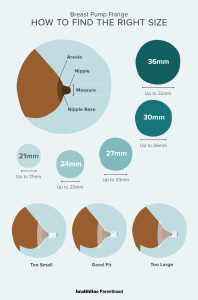When it comes to breastfeeding, choosing the right breast pump flange size can make all the difference. But how do you know what size is right for you? And why is it so important to get it right? We’ll answer those questions and more in this informative and (slightly) witty guide to breast pump flange sizes.
What is a breast pump flange?
First things first: let’s define our terms. A breast pump flange is the part of a breast pump that fits over your nipple and draws out milk. It’s typically made of plastic or silicone and comes in a range of sizes to accommodate different nipple sizes and shapes.
Why is choosing the right size flange important?
When you’re using a breast pump, you want the flange to fit snugly but not too tightly around your nipple. If the flange is too small, it can be uncomfortable and even painful to use, and it may not effectively draw out milk. On the other hand, if the flange is too large, it may not create a good seal and may not be as effective at expressing milk. Not having the right size flange can negatively affect the ability to reach max letdown of your milk.
In addition to comfort and effectiveness, choosing the right size flange can also help to prevent damage to your nipples. If the flange is too small, it can cause irritation and even bruising. On the other hand, if the flange is too large, it can create gaps between the flange and your skin, leading to poor suction and a decrease in milk production.
So, how do you choose the right size flange?
The best way to determine the right size flange for you is to measure your nipple diameter. To do this, use a ruler or a flexible measuring tape to measure the widest part of your nipple (not including the areola). Once you have your measurement, you can use a breast pump flange size chart to find the corresponding flange size.
Most breast pump manufacturers offer a range of flange sizes, so you should be able to find one that fits you perfectly. If you’re not sure which size to choose, it’s generally better to err on the side of caution and go with a slightly larger flange rather than a smaller one.
It’s also worth noting that your flange size may change over time. For example, if you have recently given birth, your nipples may be larger and more sensitive than they were before pregnancy. In this case, you may need to start with a larger flange size and then adjust as your nipples return to their normal size.
Benefits of choosing the right size flange
So, what are the benefits of choosing the right size flange? Here are just a few:
- Comfort: Using a flange that fits you properly will be much more comfortable than using one that is too small or too large.
- Effectiveness: A properly fitting flange will be more effective at expressing milk, which can help to increase your milk production and make breastfeeding easier overall.
- Nipple health: Choosing the right flange size can help to prevent irritation, bruising, and other types of damage to your nipples, which can make breastfeeding more enjoyable and sustainable in the long run.
Ultimately, choosing the right breast pump flange size is crucial for comfort, effectiveness, and nipple health when breastfeeding. By measuring your nipple diameter and using a breast pump flange size chart, you can find the perfect fit for you. Don’t be afraid to experiment with different sizes if you’re not sure which one is best – it’s better to take a little extra time to find the right flange size than to suffer through an uncomfortable or ineffective pumping experience. And remember, your flange size may change over time, so it’s always a good idea to check that you’re using the right size for your current needs.
Happy pumping!




